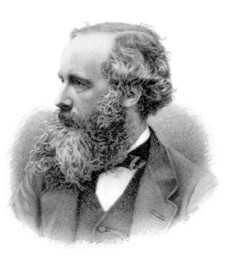James Clerk Maxwell FRSE FRS (13 June 1831 – 5 November 1879) was a Scottish mathematician[1][2] and scientist responsible for the classical theory of electromagnetic radiation describing electricity, magnetism and light as different manifestations of the same phenomenon for the first time. Maxwell's equations for electromagnetism have been called the "second great unification in physics"[3] where the first one had been realised by Isaac Newton.
With the publication of "A Dynamical Theory of the Electromagnetic Field" in 1865, Maxwell demonstrated that electric and magnetic fields travel through space as waves moving at the speed of light. He proposed that light is an undulation in the same medium that is the cause of electric and magnetic phenomena.[4] The unification of light and electrical phenomena led his prediction of the existence of radio waves. Maxwell is also regarded as a founder of the modern field of electrical engineering.[5]
He helped develop the Maxwell–Boltzmann distribution, a statistical means of describing aspects of the kinetic theory of gases. He is also known for presenting the first durable colour photograph in 1861 and for his foundational work on analysing the rigidity of rod-and-joint frameworks (trusses) like those in many bridges.
His discoveries helped usher in the era of modern physics, laying the foundation for such fields as special relativity and quantum mechanics. Many physicists regard Maxwell as the 19th-century scientist having the greatest influence on 20th-century physics. His contributions to the science are considered by many to be of the same magnitude as those of Isaac Newton and Albert Einstein.[6] In the millennium poll—a survey of the 100 most prominent physicists—Maxwell was voted the third greatest physicist of all time, behind only Newton and Einstein.[7] On the centenary of Maxwell's birthday, Einstein described Maxwell's work as the "most profound and the most fruitful that physics has experienced since the time of Newton".[8] Einstein, when he visited the University of Cambridge in 1922, was told by his host that he had done great things because he stood on Newton's shoulders; Einstein replied: "No I don't. I stand on the shoulders of Maxwell."[9]
Born13 June 1831
Died5 November 1879 (aged 48)
Resting placeParton, Kirkcudbrightshire
55.006693°N 4.039210°WNationalityScottishCitizenshipBritishAlma materUniversity of Edinburgh
University of CambridgeKnown forStatistical mechanics
Maxwell's equations
Displacement current
Maxwell relations
Maxwell–Betti theorem
Maxwell–Boltzmann distribution
Maxwell–Boltzmann statistics
Maxwell–Stefan diffusion
Maxwell's demon
Maxwell construction
Maxwell coupling
Maxwell's discs
Maxwell speed distribution
Maxwell's theorem
Maxwell's theorem (geometry)
Maxwell material
Maxwell–Wagner–Sillars polarization
Maxwell bridge
Maxwell coil
Maxwell's fish-eye lens
Maxwell's spot
Maxwell's wheel
Maxwell's thermodynamic surface
Control theory
Coherent system of units
Generalized conic
Singularity
Structural rigiditySpouse(s)Katherine Clerk MaxwellAwardsFRSE
FRS
Smith's Prize (1854)
Adams Prize (1857)
Rumford Medal (1860)
Keith Prize (1869–71)Scientific careerFieldsPhysics and mathematicsInstitutionsMarischal College, University of Aberdeen
King's College, London
University of CambridgeAcademic advisorsWilliam HopkinsNotable studentsGeorge Chrystal
Horace Lamb
John Henry PoyntingInfluencesSir Isaac Newton, Michael FaradayInfluencedVirtually all subsequent physicsSignature
https://en.wikipedia.org/wiki/James_Clerk_Maxwell


No comments:
Post a Comment